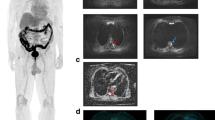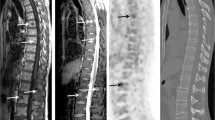Abstract
Objective
To determine the optimal 2-[18F]FDG-PET/MRI imaging protocol for the initial staging of patients with suspected or confirmed multiple myeloma.
Methods
Radiologists and nuclear medicine specialists reviewed all PET/MRI exams of 104 patients with a monoclonal gammopathy (MG). The presence of focal and diffuse bone marrow involvement (BMI) was assessed using 4 different image datasets: WB-MRI, PET, WB-PET/MRI, and WB-DCE-PET/MRI. A reference standard was established by a panel review of all baseline and follow-up imaging, and biological and pathological information. The diagnostic performance for each image dataset to detect BMI was evaluated and compared (Fisher’s exact test).
Results
Sensitivity, specificity, and accuracy for focal BMI of WB-MRI was 87%, 97%, and 92%; of PET was 78%, 97%, and 95%; of WB-PET/MRI was 93%, 97%, and 95%; and of WB-DCE-PET/MRI was 93%, 97%, and 95%, respectively. WB-PET/MRI and WB-DCE-PET/MRI were statistically superior to PET (p = 0.036) without decreasing specificity. The sensitivity, specificity, and accuracy of WB-MRI for diffuse BMI detection was 91%, 80%, and 85%; of 3DT1-PET was 53%, 89%, and 74%; of WB-PET/MRI was 98%, 66%, and 79%; and of WB-DCE-PET/MRI was 98%, 59%, and 75%, respectively. PET lacked sensitivity compared to all other dataset studies (p < 0.0001). WB-MRI had the best accuracy without reaching statistical significance when compared to the other datasets.
Conclusion
The WB-PET/MRI dataset including T1 and T2 Dixon, WB-DWI, and PET images provides optimal diagnostic performance to detect both focal lesions and diffuse BMI, with limited added value of WB-DCE for baseline staging of patients with MG.
Key Points
• The combination of morphological and functional MRI sequences and metabolic (2-[18F]FDG-PET) images increases the diagnostic performance of PET/MRI to detect focal bone lesions.
• The adjunction of dynamic contrast-enhanced sequences did not improve diagnostic performance.






Similar content being viewed by others
Abbreviations
- 2-[18F]FDG:
-
2-[18F]Fluoro-2-deoxy-D-glucose
- 3DT1-PET:
-
Hybrid fusion between 3D-T1-magnetic resonance attenuation correction (MRAC)-Dixon with 2-[18F]fluoro-2-deoxy-D-glucose
- ADC:
-
Apparent diffusion coefficient
- AUC:
-
Area under the curve
- BMEmax :
-
Maximal bone marrow enhancement
- BMI:
-
Bone marrow involvement
- CI:
-
Confidence interval
- CT:
-
Computed tomography
- DCE:
-
Dynamic contrast enhanced
- DWI:
-
Diffusion-weighted imaging
- IMWG:
-
International Myeloma Working Group
- ISS:
-
International Staging System
- MG:
-
Monoclonal gammopathy
- MRAC:
-
Magnetic resonance attenuation correction
- MRI:
-
Magnetic resonance imaging
- PET:
-
Positron emission tomography
- ROC:
-
Receiver operating characteristics
- T1T2Dixon:
-
Whole-body T1-weighted images combined with whole-body T2Dixon water–weighted images
- WB:
-
Whole body
- WB-DCE-PET/MRI:
-
The combination of WB-MRI, 3DT1-PET, and WB-DCE images
- WB-PET/MRI:
-
The combination of WB-MRI and 3DT1-PET
References
Zamagni E, Nanni C, Patriarca F et al (2007) A prospective comparison of 18F-fluorodeoxyglucose positron emission tomography-computed tomography, magnetic resonance imaging and whole-body planar radiographs in the assessment of bone disease in newly diagnosed multiple myeloma. Haematologica 92:50–55
Breyer RJ, Mulligan ME, Smith SE, Line BR, Badros AZ (2006) Comparison of imaging with FDG PET/CT with other imaging modalities in myeloma. Skeletal Radiol 35:632–640
Lütje S, de Rooy JWJ, Croockewit S, Koedam E, Oyen WJG, Raymakers RA (2009) Role of radiography, MRI and FDG-PET/CT in diagnosing, staging and therapeutical evaluation of patients with multiple myeloma. Ann Hematol 88:1161–1168
Durie BGM, Kyle RA, Belch A et al (2003) Myeloma management guidelines: a consensus report from the scientific advisors of the International Myeloma Foundation. Hematol J 4:379–398
Cavo M, Terpos E, Nanni C et al (2003) Criteria for the classification of monoclonal gammopathies, multiple myeloma and related disorders: a report of the International Myeloma Working Group. Br J Haematol 121:749–757
Moulopoulos LA, Gika D, Anagnostopoulos A et al (2005) Prognostic significance of magnetic resonance imaging of bone marrow in previously untreated patients with multiple myeloma. Ann Oncol 16:1824–1828
Cascini GL, Falcone C, Console D et al (2013) Whole-body MRI and PET/CT in multiple myeloma patients during staging and after treatment: personal experience in a longitudinal study. Radiol Med 118:930–948
Zamagni E, Patriarca F, Nanni C et al (2011) Prognostic relevance of 18-F FDG PET/CT in newly diagnosed multiple myeloma patients treated with up-front autologous transplantation. Blood 118:5989–5995
Hillengass J, Fechtner K, Weber M-A et al (2010) Prognostic significance of focal lesions in whole-body magnetic resonance imaging in patients with asymptomatic multiple myeloma. J Clin Oncol 28:1606–1610
Cavo M, Terpos E, Nanni C et al (2017) Review role of 18F-FDG PET/CT in the diagnosis and management of multiple myeloma and other plasma cell disorders: a consensus statement by the International Myeloma Working Group. Lancet Oncol 18:e206–e2017
Fechtner K, Hillengass J, Delorme S et al (2010) Staging monoclonal plasma cell disease: comparison of the Durie-Salmon and the Durie-Salmon PLUS staging systems. Radiology 257:195–204
Hillengass J, Usmani S, Rajkumar SV et al (2019) International myeloma working group consensus recommendations on imaging in monoclonal plasma cell disorders. Lancet Oncol 20:e302–e312
Moreau P, Attal M, Caillot D et al (2017) Prospective evaluation of magnetic resonance imaging and [18 F]fluorodeoxyglucose positron emission tomography-computed tomography at diagnosis and before maintenance therapy in symptomatic patients with multiple myeloma included in the IFM/DFCI 2009 Tri. J Clin Oncol 35:2911–2918
Koutoulidis V, Fontara S, Terpos E et al (2017) Quantitative diffusion-weighted imaging of the bone marrow: an adjunction tool for the diagnosis of a diffuse mr imaging pattern in patients with multiple myeloma. Radiology 282:484–493
Giles SL, Messiou C, Collins DJ et al (2014) Whole-body diffusion-weighted MR imaging for assessment of Treatment response in Myeloma. Radiology 271:785–794
Moulopoulos LA, Dimopoulos MA, Christoulas D et al (2010) Diffuse MRI marrow pattern correlates with increased angiogenesis, advanced disease features and poor prognosis in newly diagnosed myeloma treated with novel agents. Leukemia 24:1206–1212
Nosàs-Garcia S, Moehler T, Wasser K et al (2005) Dynamic contrast-enhanced MRI for assessing the disease activity of multiple myeloma: a comparative study with histology and clinical markers. J Magn Reson Imaging 22:154–162
Lin C, Luciani A, Belhadj K et al (2009) Patients with plasma cell disorders examined at whole-body dynamic contrast-enhanced MR imaging: initial experience. Radiology 250:905–915
Lin C, Luciani A, Belhadj K et al (2010) Multiple myeloma treatment response assessment with whole-body dynamic contrast-enhanced MR imaging. Radiology 254:521–531
Messiou C, Hillengass J, Delorme S et al (2019) Guidelines for acquisition, interpretation, and reporting of whole-body MRI in myeloma: Myeloma Response Assessment and Diagnosis System (MY-RADS). Radiology 291:5–13
Rajkumar SV, Dimopoulos MA, Palumbo A et al (2014) International Myeloma Working Group updated criteria for the diagnosis of multiple myeloma. Lancet Oncol 15:e538–e548
Filonzi G, Mancuso K, Zamagni E et al (2017) A comparison of different staging systems for multiple myeloma: can the MRI pattern play a prognostic role? AJR Am J Roentgenol 209:152–158
Ormond Filho AG, Carneiro BC, Pastore D et al (2019) Whole-body imaging of multiple myeloma: diagnostic criteria. Radiographics 39:1077–1097
Dutoit JC, Verstraete KL (2017) Whole-body MRI, dynamic contrast-enhanced MRI, and diffusion-weighted imaging for the staging of multiple myeloma. Skeletal Radiol 46:733–750
Larbi A, Omoumi P, Pasoglou V et al (2019) Whole-body MRI to assess bone involvement in prostate cancer and multiple myeloma: comparison of the diagnostic accuracies of the T1, short tau inversion recovery (STIR), and high b-values diffusion-weighted imaging (DWI) sequences. Eur Radiol 29:4503–4513
Lecouvet FE, Boyadzhiev D, Collette L et al (2020) MRI versus 18F-FDG-PET/CT for detecting bone marrow involvement in multiple myeloma: diagnostic performance and clinical relevance. Eur Radiol 30:1927–1937
Landis JR, Koch GG (1977) The measurement of observer agreement for categorical data. Biometrics 33:159–174
Basha MAA, Hamed MAG, Refaat R et al (2018) Diagnostic performance of 18F-FDG PET/CT and whole-body MRI before and early after treatment of multiple myeloma: a prospective comparative study. Jpn J Radiol 36:382–393
Pawlyn C, Fowkes L, Otero S et al (2016) Whole-body diffusion-weighted MRI: a new gold standard for assessing disease burden in patients with multiple myeloma? Leukemia 30:1446–1448
Sachpekidis C, Mosebach J, Freitag MT et al (2015) Application of (18)F-FDG PET and diffusion weighted imaging (DWI) in multiple myeloma: comparison of functional imaging modalities. Am J Nucl Med Mol Imaging 5:479–492
Hillengass J, Weber MA, Kilk K et al (2014) Prognostic significance of whole-body MRI in patients with monoclonal gammopathy of undetermined significance. Leukemia 28:174–178
Bartel TB, Haessler J, Brown TLY et al (2009) F18-fluorodeoxyglucose positron emission tomography in the context of other imaging techniques and prognostic factors in multiple myeloma. Blood 114:2068–2076
Ho C, Chen S, Leung YL et al (2014) 11C-acetate PET/CT for metabolic characterization of multiple myeloma: a comparative study with 18F-FDG PET/CT. J Nucl Med 55:749–752
Lin C, Ho C-L, Ng S-H et al (2014) (11)C-acetate as a new biomarker for PET/CT in patients with multiple myeloma: initial staging and postinduction response assessment. Eur J Nucl Med Mol Imaging 41:41–49
Song M-K, Chung J-S, Lee J-J et al (2014) Magnetic resonance imaging pattern of bone marrow involvement as a new predictive parameter of disease progression in newly diagnosed patients with multiple myeloma eligible for autologous stem cell transplantation. Br J Haematol 165:777–785
Hillengass J, Bäuerle T, Bartl R et al (2011) Diffusion-weighted imaging for non-invasive and quantitative monitoring of bone marrow infiltration in patients with monoclonal plasma cell disease: a comparative study with histology. Br J Haematol 153:721–728
Mayerhoefer ME, Prosch H, Beer L et al (2020) PET/MRI versus PET/CT in oncology: a prospective single-center study of 330 examinations focusing on implications for patient management and cost considerations. Eur J Nucl Med Mol Imaging 47:51–60
Morsing A, Hildebrandt MG, Vilstrup MH et al (2019) Hybrid PET/MRI in major cancers: a scoping review. Eur J Nucl Med Mol Imaging 46:2138–2151
Funding
The authors state that this work has not received any funding.
Author information
Authors and Affiliations
Corresponding author
Ethics declarations
Guarantor
The scientific guarantor of this publication is Robert Burns.
Conflict of Interest
The authors of this manuscript declare no relationships with any companies whose products or services may be related to the subject matter of the article.
Statistics and Biometry
Two of the authors (Robert Burns and Sébastien Mulé) have significant statistical expertise.
Informed Consent
Written informed consent was waived by the Institutional Review Board.
Ethical Approval
Institutional Review Board approval was obtained. (CERIM, approval number CRM-1912–048).
Methodology
• retrospective
• diagnostic study
• performed at one institution
Additional information
Publisher’s Note
Springer Nature remains neutral with regard to jurisdictional claims in published maps and institutional affiliations.
Supplementary Information
Below is the link to the electronic supplementary material.
Rights and permissions
About this article
Cite this article
Burns, R., Mulé, S., Blanc-Durand, P. et al. Optimization of whole-body 2-[18F]FDG-PET/MRI imaging protocol for the initial staging of patients with myeloma. Eur Radiol 32, 3085–3096 (2022). https://doi.org/10.1007/s00330-021-08388-6
Received:
Revised:
Accepted:
Published:
Issue Date:
DOI: https://doi.org/10.1007/s00330-021-08388-6




